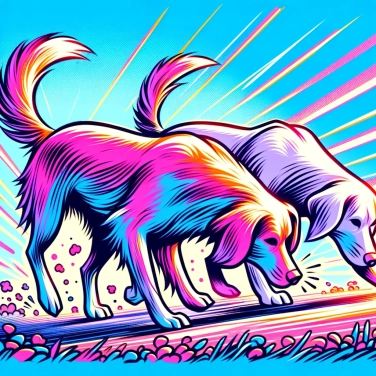Dogs constantly sniff when they walk because they are exploring the world and communicating with other dogs through the scents left by them. Their highly developed sense of smell allows them to detect crucial information about their surroundings.

The dog has more than 200 million olfactory receptors in its snout, while humans have only about 5 million. Its brain even has a large area entirely dedicated to analyzing smells. This allows it to detect each scent precisely, even at very low concentrations. While we perceive just a general smell of forest or fresh grass, the dog perceives a whole universe: the trail left by an animal that passed several hours earlier, the olfactory mark of a fellow dog, and even a person's emotional state. In short, the pup is a true nose specialist.
When your dog sniffs the ground, he does a sort of quick scan of the neighborhood. Each scent gives him a wealth of information: which animals live there, whether familiar or unfamiliar humans have passed recently, and even what has changed since his last visit. It's his way of getting the latest news from the area, as if he were checking his canine version of social media. Dogs have such a developed sense of smell that just a few whiffs are enough to create a detailed picture of their immediate environment. Sniffing while on a walk is simply his natural way of exploring, understanding where he is, and satisfying his daily curiosity.
When a dog sniffs a street corner, it decodes a whole bunch of messages left by other dogs passing by. These messages are like chemical post-it notes — filled with information about the sex, age, health, reproductive status, and even the mood of the dog that was there just before. By smelling these scents, the dog knows exactly which animal frequents the area, when it passed by, or whether it was relaxed, fearful, or aggressive. It then leaves its own information as well, in order to maintain this olfactory canine social network. A walk quickly becomes a large silent conversation, where each pee break is a real exchange of news and gossip.
When a dog sniffs the ground, it often looks for clues about potential food that may be hidden or abandoned. Its ultra-sensitive nose also allows it to quickly detect certain potential dangers, such as toxic substances, the presence of a predator, or even a hostile animal nearby. Sniffing also helps it to identify objects of interest, like the scent of a human or familiar animals it knows well. Thanks to its particularly sharp sense of smell, it is constantly keeping itself informed about the possibilities and risks in its immediate environment.
Sniffing is an extremely mentally stimulating activity for a dog. When it uses its nose to explore, its brain is actively working, helping it to stay calm and balanced. It's like a kind of mental and sensory gymnastics that tires them out as much as a good walk or a game. Allowing your dog to sniff its environment regularly will help reduce stress, combat boredom, and overall improve its physical and mental well-being. It's also very helpful for nervous or anxious dogs: providing them with plenty of opportunities to sniff promotes better emotional stability on a daily basis.
Dogs have about 300 million olfactory receptors, compared to only 5 to 6 million in humans. Their sense of smell is therefore up to 50 times more sensitive than ours!
Each dog has a unique olfactory footprint, comparable to our fingerprints. Sniffing is also a way for them to identify each other and recognize their surroundings.
The part of a dog's brain dedicated to interpreting smells is up to 40 times larger proportionally than in humans: this explains why smell is their primary sense during walks.
Sniffing during a walk is extremely mentally stimulating for your dog. A walk of less than 15 minutes focused on scent exploration can be just as beneficial and even more mentally exhausting than a quick half-hour stroll.
Absolutely! You can easily stimulate and develop your dog's sense of smell through simple games and exercises that you can do at home or during walks. For example, you can practice scent games by hiding treats or objects for your dog to find using its powerful nose.
All dogs have a highly developed sense of smell compared to humans, but certain breeds naturally possess a particularly strong sense of smell, such as hunting dogs, hounds, and herding dogs. However, each dog is unique, and their olfactory ability can vary slightly from one individual to another.
Although it is sometimes necessary to encourage your dog to move forward, sniffing is essential for their mental well-being. In fact, it allows them to explore, gather information about their environment, and can even help reduce their stress. Therefore, it is important to give your dog time and freedom to use their sense of smell during your outings.
Sure! Here’s the translation: "Yes! The olfactory activity requires a lot of concentration and analysis from the dog's brain. Sniffing is an excellent way to provide mental stimulation that can help him expend energy in ways other than physical activity. It's just as effective for mentally tiring your dog as a play session or physical exercise."
Some places are particularly rich in scents, containing important olfactory traces for a dog. These areas can indicate the recent presence of other animals or dogs, food, or even a potential danger that your dog is trying to analyze. It’s his way of gathering detailed information about his environment.

No one has answered this quiz yet, be the first!' :-)
Question 1/5